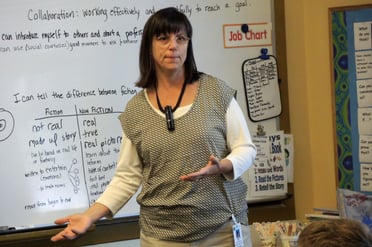Oregon students have been in school for a few weeks, now. They’re adjusting to new teachers, new classrooms, new expectations. Some kids have returned to buildings that are quite different from the schools they left last spring. OPB is tracking a group of kids from East Portland as they move through school. Most kids in OPB’s Class of 2025 attend a school that got a major overhaul this summer. Rob Manning checks out the changes at Earl Boyles Elementary School, and what they mean for the second graders we’re following.
 Debra and Jason Rabedeau just dropped off their second grader for the first day of school. They’re touring Earl Boyles Elementary, with their youngest, Roy. They saw Roy’s classroom in the new preschool wing, and the new community library.
Debra and Jason Rabedeau just dropped off their second grader for the first day of school. They’re touring Earl Boyles Elementary, with their youngest, Roy. They saw Roy’s classroom in the new preschool wing, and the new community library.
Roy likes the new playground.
Principal Ericka Guynes joins them out there – but reminds Roy that he’s at school.
“You see that window right over there? There are some kindergarten students that are in there, right now, and they’re learning,” Guynes says. “So when we’re in here, we’ll have to be kind of quiet, so be respectful, OK? But I want you to be able to explore it so that you’ll know what it’s going to look like when you’re out here, alright? There are some fun things. Want me to show you some toys? Come on!”
The new wing and playground resulted from a successful bond campaign and years of fundraising and planning. But these changes won’t mean as much to the older kids as some harder-to-see technology improvements.
Laptops are coming, but they’re not in students’ hands yet.
The kids do have something new for their ears and voices.
“This microphone system was a great surprise for us, actually,” says second grade teacher Jen DiFrances - an immediate fan of the new Redcat audio system. Teachers have microphones the size of a lipstick case to amplify their voices, all over a classroom. Students can use it, too.

Teacher Deb McGowan is grateful for it, in a noisy classroom of 28 second graders.
“I’ve always wanted a sound system, because it gives the kids the opportunity to make their voice heard,” McGowan says. “And when you’ve got so many kids in the classroom, and there’s that nice hum of kids, and you’ve got a little soft speaker, then you don’t hear that little person, and his voice just gets kind of lost in the crowd.”
The audio system is especially handy for story time in Ms McGowan's class.
McGowan uses the sound system all the time. The black mic hangs on a lanyard around her neck.
On this morning, her students sit on the floor, ready to talk about the benefits of good behavior. As kids raise their hands, McGowan brings the mic near their mouths. They know the drill.
“If you’re sitting criss-cross applesauce, I’ll be able to walk right through, and I don’t want to step on anyone’s fingers. Thank you so much,” she says.
“We’re being good listeners,” one child says into the microphone.
“It’s time to party,” says another.
“Yes, in a way,” McGowan responds.
Next door, Jen DiFrances and a student, Josh, have mics around their necks as they demonstrate how to have a polite conversation. The difference in sound is subtle - but noticeable.
DiFrances says the sound system helps engage and focus energetic kids who might get distracted. But the bigger impact might be for the quieter kids, like little Roy’s older brother. His name is Dude, and he’s in Deb McGowan’s class.
“I’m impressed with Dude because he is one of those little people that he’s really shy and reserved and always sits in the back,” McGowan says. “Recently, with where I sit with the teacher chair, he’s right up there with me, and he’s just looking at me, waiting to speak. So we’re giving those kids a voice.”
Outside of class, I ask a handful of students for their reactions to the sound system. The reviews are mixed.
Dude and his classmate, Vivianna, use the same word to describe it: Scary.
Why is it scary?
“It makes your voice more louder,” Vivianna says. “And I talk more louder.”
But Vivianna says she can hear better, and she sees benefits for quiet students.
Josh - who did the polite conversation exercise with Mrs. DiFrancis - uses two words to describe the new sound system: “Awesome and cool.”
Josh’s classmate, Shelby, says she had fun using the sound system in a group presentation to summarize a story they’d read.
“I used it when we were - we made a poster, and we were talking about it,” she says.
Shelby liked that excitement, but the idea of presenting - even in a group - to more than twenty classmates is what Dude found “scary.” It’s different when he’s sitting with the whole class on the carpet, and the mic goes to kids when they raise their hands.
“I want to ask questions more,” he says.
Teachers say they feel less exhausted at the end of each day. They say they don’t have to raise their voices, in part because kids hear them the first time, more often. And, teachers say, they speak less, because it’s easier to have students do more of the talking.

